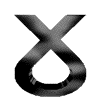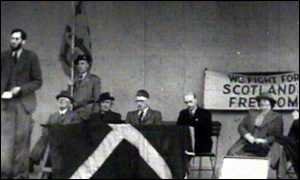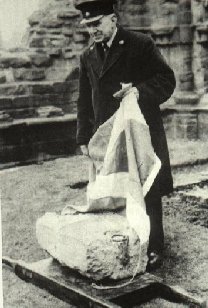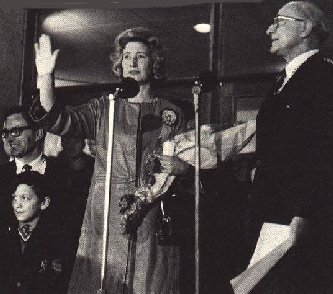 |
Air's SNP Page |  |
 |
Air's SNP Page |  |
Coming soon .........Independence !
I have been a member of the Scottish National Party since 1992. Since then I have been actively involved in all the local and General Election campaigns, and the Devolution campaign when I took part in a live TV debate on the issue. I am currently Branch and Membership Secretary of the Camelon / Falkirk branch of the party.
I believe that if Scotland is ever to take its place on the world stage then Independence is the only way forward. This is NOT to say that I, or the majority of SNP members and supporters are anti-English, a misconception by some people that continues to annoy me. Being anti-Westminster Government does not make me anti-English. On the contrary - I actually believe that relations between Scotland and England would, if anything, improve if we were an independent country.
Hopefully I will be adding more details and history about the Scottish National Party here soon. Please check back. In the meantime you can check out the party's homepage.
A Brief History
Since the late 1890's there had been calls for a National Party in Scotland. However, it was not until the 1920's that pro independence parties began to emerge as it became obvious that none of the UK parties were going to deliver on home rule.
In 1921 the Scots National League was formed by Ruaraidh Erskine of Marr. This was followed in 1927 by the Glasgow University Scottish Nationalist Association, formed by law student John MacCormick and the Scottish National movement, led by the poet Lewis Spence.
In January 1928 a joint meeting was held between the three groups, and the National Party of Scotland was formed. The aim of this party was stated as :
"Self Government for Scotland with Independence status within the British group of nations". In 1932 the Scottish Party was formed, and it was not long until the two parties merged. At a meeting on December 14th 1933 the amalgamation of the two parties was proposed and on the 7th April 1934 the Scottish National Party was born. |
 |
During the 1930's some Nationalists took part in various forms of peaceful protest. In 1937 the Wallace Sword was removed from the Wallace Monument at Stirling and hidden under Bothwell Bridge, and Union Jack flags were replaced with the Saltire on various buildings. However, electoral success was not achieved, partly due to internal splits within the party. In 1942 John MacCormick, who had been one of the key figures in the creation of the party, left taking many of his supporters with him, to form the Scottish Convention, and although the SNP saw its first electoral success in 1945 with the election of the first SNP Member of Parliament in a by-election in Motherwell, where Dr Robert McIntyre won 51.4% of the vote, this success was to be shortlived, and the seat was lost just a few weeks later in the General Election.
However, the Scottish Convention was to prove more successful. On 29th October 1949 it launched the Scottish Covenant, a petition demanding more self government for Scotland, and by the end of 1950 more than two million Scots had signed. This was seen as a stunning achievement, and kept the issue of Home Rule for Scotland alive.
Although the SNP only gained 7.4% of the vote in the 1950 General Election and the 1950's saw little improvement in electoral success for the Party, there was evidence that the mood of the Scottish people was changing.
| On Christmas Day 1950 Scotland awoke to the
headlines that the Stone
Of Destiny
(the sandstone block on which Scottish Kings had
traditionally been crowned since medieval times, and
which had been stolen from Scotland by Edward 1 in 1296)
had been stolen from Westminster Abby by a group of four
Glasgow University students. The Stone was hidden in
Scotland, and then displayed at Arbroath
Abbey, before eventually being
returned to Westminster Abbey, although there is debate
as to whether the stone returned was the original or a
replica. The event captured the public imagination and
commanded total public sympathy and was the best piece of
publicity the home rule movement ever achieved. In 1996, 700 years after Edward 1 took the stone from Scone, the Tory Government returned the stone to Scotland in an effort to appease the growing tide of nationalist feelings. |
 The custodian of Arbroath Abbey recovers the stone draped in the saltire. |
In 1953 the Covenant Association raised a legal action challenging the right of the newly crowned Queen to call herself Elizabeth the second as she was the first Elizabeth to be Queen of Scots and of the UK as a whole, and some Nationalists, with the general support of the Scottish people, vandalised and even blew up post boxes carrying the Queen ER 2 insignia.
The 1960's
By the early 1960's support for the SNP had started to grow. This was partly fuelled by the Governments decision to base Polaris nuclear submarines on the Clyde, a decision that angered anti-nuclear campaigners, and which took on a distinctly Scottish dimension as it appeared to many that a remote English Government had decreed that Scotland was expendable and that the country had been sold down the river to keep America happy. Many people that would otherwise have looked to Labour began to turn to the SNP, and throughout the 1960's the party began to pick up votes in by-elections. The Party established constituency and branch organisations and appointed their first full time organiser. Between 1962 and 1968 the party claimed SNP membership had soared from 2000 to 100,000, and in the 1966 General Election the Party fought its largest ever number of seats with 23 contested, and the Party gained 14.3% of the vote.
 Winnie Ewing's historic victory at Hamilton |
In the 1967 local elections the SNP took over
200,00 votes and gained 69 seats. However the Party's
real breakthrough came in the 1967 Hamilton by-election
when Winne Ewing overturned a 71% Labour majority to take
the seat. The Party went on to win 30% of the vote in the
1968 local elections and Dr Robert McIntyre, the SNP's
first ever MP in 1945, became the Provost of Stirling. In the 1970 General Election Donald Stewart became the first ever SNP candidate to be elected at a General Election. However, the new Tory Government also became the first which had neither a majority of seats, nor a majority of votes in Scotland. |
The 1970's
| In the 1970's Scotland's constitutional
restlessness came to a head. The home rule 'Scottish
Question' dominated political life both north and south
of the border as each of the political parties attempted
to play the right 'Scottish' card. There were various reasons for this. The new conservative administration called for more competition, tax cuts, welfare cuts and the curbing of union power. They believed that people 'should stand on their own to feet' instead of relying on the State, and this policy also extended to business. Government grants were slashed and a radical Industrial Relations Act was passed which curbed trade union rights. This resulted in 1970 becoming the worst year for strikes since the General Strike of 1926, and unemployment in Scotland leapt by a massive 43% in the first year of the administration.
|
This page last updated on 05 November 1999